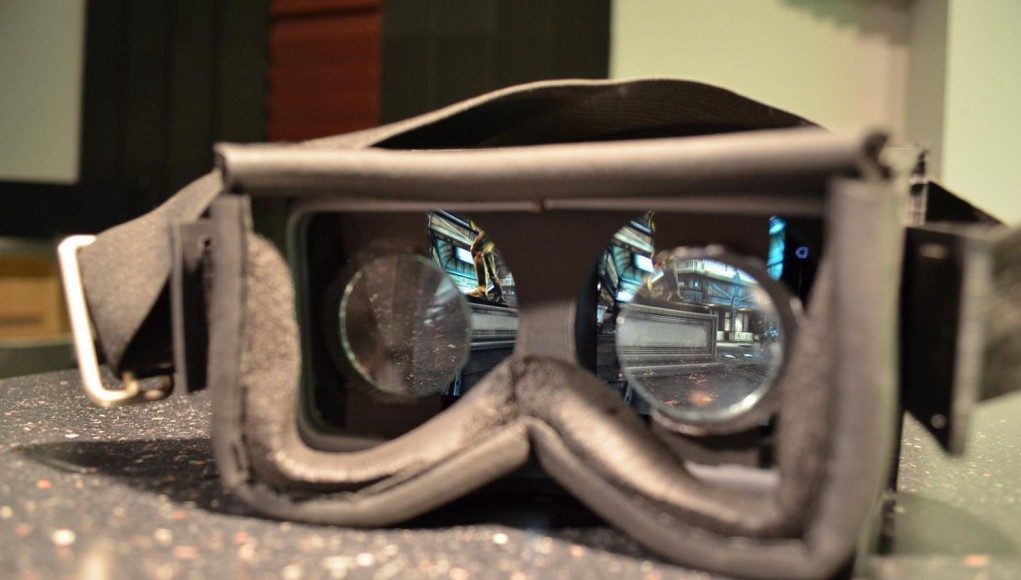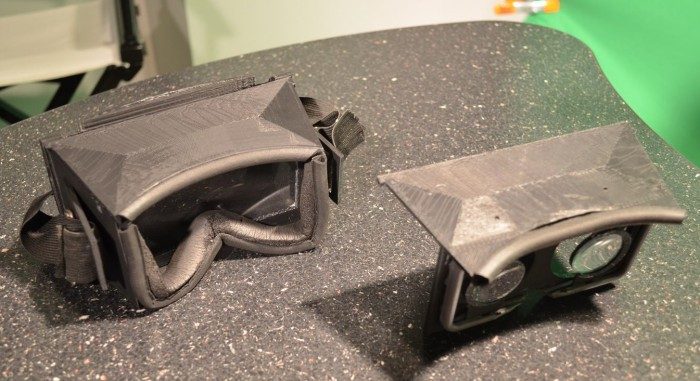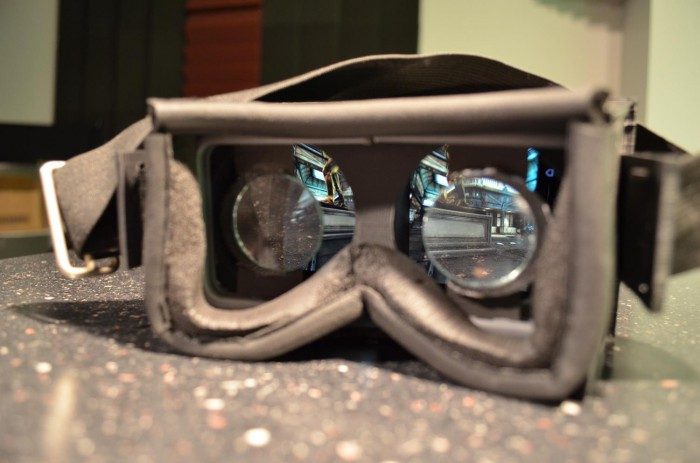Recently I sat down with Xyson Labs CEO Jeff Hyson to check out the Xcope, another entry in the world of smartphone HMDs. The Xcope makes several smart additions to the typical ‘strap a smartphone to your face’ formula that could give it an edge over similar devices.
Xyson Labs‘ Xcope is a head mount that uses your smartphone as a VR/AR platform. Slide your device into the Xcope and then strap it to your head for media viewing or game playing.
This approach is undoubtedly similar to Durovis Dive, VRAse, and VR2Go, but it makes two smart changes to the prevailing formula which could make it much more appealing.
Mono-lens for Existing Applications
First, and perhaps most important, is the mono-lens which can be quickly swapped in and out of place with the stereo lenses. The mono-lens is a large Fresnel lens which allows the Xcope to be used with any existing application. This means that there’s tons of existing content to be used right out of the box, rather than waiting for custom-made applications which are currently the achilles’ heel of the smartphone HMD concept.
With the mono-lens I was able to play Modern Combat 4, an Android title meant to be played with the phone in your hands, using Xcope and a bluetooth controller; it felt like the smartphone (an HTC One) had suddenly become a huge 1080p HDTV. This is massively appealing for mobile gaming.
The mono-lens also enabled the use of one of a myriad of AR applications which used the phone’s camera to detect a paper AR marker and overlay a troll model on top of it. I was quite impressed with the tracking (when it wasn’t jumpy, as commonly happens with optical marker tracking), but developers are still scratching their head for practical applications of this type of AR tech.
The mono-lens lets you focus on the screen even though it’s just a few inches from your face, but there is definitely some eye-strain involved. I didn’t have any significant problems playing for a few minutes with several applications, but I could feel that my eyes were not relaxed and this could become tiresome during extended sessions. Without rendinerg a separate view for each eye, such eye-strain is likely inevitable when focusing on an image so close to your face.
Full Enclosure with Finger Ports
Xcope is fully enclosed, which prevents light from invading the HMD and ruining immersion. This would create issues for interacting with your phone, but Xyson Labs put two finger ports on the bottom of Xcope to easily reach your fingers up and tap the screen without removing it from the HMD every time you need to change content or press a button. The ports are covered by fabric flaps which keep light out when your fingers aren’t in there.
The finger ports are a great idea because they allow Xcope to retain the immersiveness of a full enclosure without compromising usability.
VR Gaming with Xcope
Xcope is the first smartphone HMD that I’ve had the chance to try, and while content is a major hurdle for devices like this, I’m now convinced that smartphone head mounts could become a huge deal in the near future.
With the stereoscopic lenses inserted, I tried the Shadowrun demo in 3D with headtracking. Aside from issues with image convergence and warping (which I believe can be fixed in software for titles that are specifically made for VR), I was really impressed with the experience. This might not be the case for every smartphone, but the HTC One used for testing ran the game near to 60 FPS by my estimate, and the head tracking felt extremely tight—practically as good as what I’ve felt with the Oculus Rift.
Horizontal field of view was around 65 degrees with the stereoscopic lenses (which will vary depending upon smartphone screen size) and the detail of the image was very good thanks to the HTC One’s 1080p display providing 960×1080 resolution to each eye.
Modern smartphones have almost everything needed for VR, and most of us are already carrying them. If folks like Xyson and others can spur developers to create VR experiences, smartphone HMDs are likely to take off in a big way.
Xcope Now on Kickstarter
The Xcope Kickstarter is live and Xyson Labs is seeking to raise $50,000 over 25 days. Each unit comes with the swappable stereoscopic and mono-lenses with the earliest units delivering in March 2014. Early-bird pricing starts at $55, but even if you don’t make it in time for that tier, the price only rises to $70, making it significantly cheaper than VRAse ($~124). Core tiers are below:
| Price–Tier | Reward | # Available |
|---|---|---|
| $55 – Xcope I Got Here First Level | Xcope with stereoscopic / mono-lens inserts – Estimated delivery: March 2014 | 177 |
| $60 – Xcope Developer Level | Xcope with stereoscopic / mono-lens inserts – Estimated delivery: February 2014 | 232 |
| $70 – Xcope Level | Xcope with stereoscopic / mono-lens inserts – Estimated delivery: April 2014 | no limit |
| $110 – Xcope Travel Pack | Xcope with travel case with room for both lens inserts – Estimated delivery: March 2014 | no limit |
Xyson Labs says that Xcope is tested to work with the following smartphones:
- HTC One
- Galaxy Note 2/3
- Galaxy S4
- Galaxy S3
- iPhone 4/4S
- iPhone 5/5C/5S
- iPod Touch 4th/5th gen
- Any phone with a screen between 3.5″ and 5.5″ and without a slide-out keyboard should fit.
The company intends to launch a developer community to help focus devs on creating content for the Xcope.










